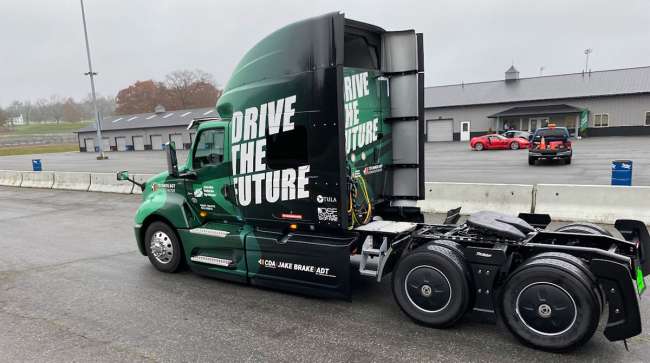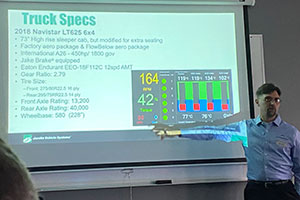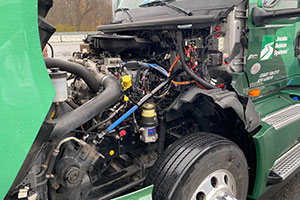Staff Reporter
Jacobs Showcases New Valvetrain Systems With Demo Truck

[Stay on top of transportation news: Get TTNews in your inbox.]
THOMPSON, Conn. — Jacobs Vehicle Systems on Nov. 1 showcased new cylinder deactivation and active decompression systems while launching the third iteration of its demonstration truck to highlight the new technologies.
The International LT625 tractor being used for the demo was custom-built to provide fleets, drivers, industry associations, manufacturers and media members firsthand experience with the technologies. The truck was unveiled to reporters, who also had the opportunity to drive it.
“We started doing truck demos in 2016,” said Steve Ernest, Jacobs’ vice president of engineering and business development. “That was really a way to get our technology on to a vehicle and demonstrate that for our customers. Normally, we sell to the engine companies, not vehicle folks, so it was a way to reach past our customers to do a little bit of pull marketing and that has been effective. We’re on our third truck now.”

Ernest
Jacobs first provided an introduction to the truck and its new systems as well as a safety briefing. The reporters then took turns driving the truck at Thompson Speedway Motorsports Park. The lightly rained on track had several tight turns and straightaways.
Two instructors were present to comment on the systems. They could also refer to a monitor attached to the dashboard that showed various engine metrics such as rpm, torque, mph, temperatures and active cylinders.
Jacobs then shuttled the group to its headquarters in Bloomfield. There, a tour of the facility was provided to show where the different parts and systems are manufactured and tested. Cummins Inc. acquired the company earlier in the year and is expected to invest in updating the facility to increase production numbers.

Jacobs Vehicle Systems' Robb Janak details the demonstration truck's specifications. (Connor D. Wolf/Transport Topics)
“The two focuses we have for this is basically exhaust thermal management,” said Robb Janak, Jacobs’ director of new technology. “That’s everything that we’re going for in emissions reduction in this next iteration. Because we’ve already adopted SCR aftertreatment and we know the SCR systems need to be hot.”
Cylinder deactivation (CDA) is one of the main technologies the demo truck showcased. It is a modular valve actuation technology that improves fuel efficiency by turning a six-cylinder engine into four cylinders or less. Active decompression technology (ADT) also was introduced. It reduces cabin shake when trucks start up and shut down to address user resistance to engine stop-start technology.
“The cylinder deactivation is one of our key solutions to that thermal management mode because we are able to get at it from both the thermal management side, but also fuel consumption,” Janak said. “We’re deactivating the intake and exhaust valves to prevent the air from going into those cylinders. And you couple that with deactivating the injection so you’re no longer putting fuel in those. So basically, you’re taking a larger engine, six cylinders, and turning it down.”

A look under the hood of the demo truck shows Jacobs Vehicle Systems' new technology. (Connor D. Wolf/Transport Topics)
CDA is designed to reduce emissions by achieving higher exhaust and aftertreatment temperatures at low load and start up. Jacobs found while testing the system it potentially can improve overall fuel economy by as much as 25%.
“We’re actually operating those fired cylinders more efficiently, so they’re running at a higher temperature,” Janak said. “We’re also pumping a lot less cold air through the engine on those extra cylinders, and that’s where the thermal benefits come from. So, we see fuel consumption improves from this and because we keep the aftertreatment system hot and get it hot faster, we’re able to lower the total NOx.”

Host Seth Clevenger and ZF’s Julien Plenchette consider how today’s advanced driver-assist systems technologies can support drivers and make them feel better behind the wheel. Tune in above or by going to RoadSigns.ttnews.com.
ADT, in turn, is designed to improve cold engine starts to make startups faster while reducing wear on engine components. This system also enables a faster transition from an electric motor to an internal combustion engine in hybrid vehicles.
“The other key here is that we’re trying to design these systems to be very modular so customers can pick and place whatever they want,” Janak said. “So, add cylinder deactivation, add engine braking. We’re not making them dependent on each other. But if you have both the engine braking and the cylinder deactivation together, then you actually make that next step of high-power engine braking.”
Janak is hopeful that active decompression will discourage drivers from idling by making stop-start more acceptable. He pointed to legislation that is refocusing emission-reduction efforts on idle, low-speed and low-load operation modes. Janak noted that thermal management is necessary to address emissions produced during those operation modes.
“Ultimately, there’s a bunch of emissions challenges coming up,” Ernest said. “All those regulations are pushing the emissions way down, even further than where they are today. There are technologies out there that can help with that and the aftertreatment systems. But they tend to get cold during low load and idle operations. And so, our devices can help heat that up.”
Want more news? Listen to today's daily briefing below or go here for more info:

